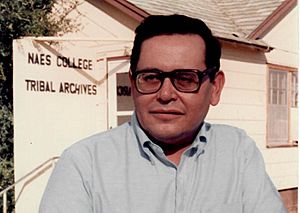Robert V. Dumont Jr. facts for kids
Quick facts for kids
Robert Vaughn Dumont Jr.
|
|
|---|---|
 |
|
| Born | June 29, 1940 |
| Died | May 1997 (aged 80–81) Wolf Point, Montana, U.S.
|
| Nationality | Assiniboine |
| Relatives | Nancy Dumont (sister) |
Robert V. Dumont Jr. (1940–1997) was an important Native American leader in education. He worked in Chicago, Illinois, and on the Fort Peck Indian Reservation in Montana. He is best known for helping create the Native American Educational Services College and for being its first academic director.
Contents
Early Life and Education
Robert Dumont Jr. was a member of the Assiniboine nation. He grew up near Wolf Point, Montana, and finished high school there in 1958.
He went to the University of Montana and earned a degree in English Literature in 1962. Later, in 1966, he earned a master's degree in Education from Harvard University. After his studies, he moved to Chicago.
Working for Native American Education
Robert Dumont became a strong leader in Chicago's Native American community. He was part of the second group of leaders at the city's American Indian Center. This center was started in 1953 to help Native American people.
Dumont worked on the center's education committee with his sister, Nancy Dumont, and Faith Smith. In 1970, these three helped start a new group called the Native American Committee (NAC). This group wanted to create schools and colleges for Native Americans, run by Native Americans.
Creating New Schools
In 1971, Dumont helped lead the NAC's first big project, the Little Big Horn School. This school worked with Chicago Public Schools to help Native American high school students. It taught eighty high school students and twenty preschool students.
Because this school was so successful, the NAC started another program in 1973 called the O-Wai-Ya-Wa Elementary School.
Founding NAES College
In 1974, the NAC took an even bigger step. They founded the Native American Educational Services College (NAES College). This was the first college designed and run by Native Americans. Robert Dumont was a key part of the team that planned the college and its courses. They wanted to combine traditional tribal knowledge with regular academic studies.
Later, in the mid-1970s, NAES College began opening branches on Native American reservations. Robert Dumont moved back to Montana to help set up the NAES site on the Fort Peck Indian Reservation. He also worked for the Fort Peck Tribal Board.
Legacy and Impact
Robert Dumont's work continues to be remembered. The Robert Dumont Building at the Fort Peck Community College in Poplar, Montana, is named after him. This building has classrooms, computer labs, and offices.
When he passed away in 1997, the Billings Gazette newspaper praised him. They said he encouraged people to think and act in ways that best served Native people. He taught that failure was not an end, but a chance to learn and work for positive change for Native communities.
See also
- Urban Indian
- Native American civil rights
- Red Power movement

